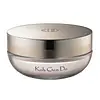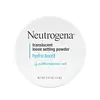What's inside
What's inside
 Key Ingredients
Key Ingredients

 Benefits
Benefits

 Concerns
Concerns

 Ingredients Side-by-side
Ingredients Side-by-side

Vinyl Dimethicone/Methicone Silsesquioxane Crosspolymer
Methyl Methacrylate Crosspolymer
Lauroyl Lysine
Skin ConditioningBoron Nitride
AbsorbentSynthetic Fluorphlogopite
Dimethicone
EmollientSqualane
EmollientSilica
AbrasiveSimmondsia Chinensis Seed Oil
EmollientButyrospermum Parkii Oil
EmollientPerilla Ocymoides Seed Oil
Skin ConditioningArgania Spinosa Kernel Oil
EmollientVaccinium Macrocarpon Seed Oil
Skin ConditioningGevuina Avellana Seed Oil
Skin ConditioningAleurites Moluccanus Seed Oil
Skin ConditioningCeramide Ng
Skin ConditioningSodium Hyaluronate
HumectantHydrolyzed Yeast Extract
Skin ConditioningPolyglutamic Acid
Skin ConditioningGlycosphingolipids
EmollientHydrogenated Lecithin
EmulsifyingLysolecithin
EmulsifyingHibiscus Esculentus Fruit Extract
Skin ConditioningPolyquaternium-51
Skin ConditioningWater
Skin ConditioningButylene Glycol
HumectantSodium Hydroxide
BufferingCitric Acid
BufferingAscorbyl Palmitate
AntioxidantAscorbyl Dipalmitate
AntioxidantTocopherol
AntioxidantChlorphenesin
AntimicrobialHydrogen Dimethicone
Sodium Dehydroacetate
PreservativePhenoxyethanol
PreservativeMica
Cosmetic ColorantIron Oxides
CI 77491
Cosmetic ColorantCI 77492
Cosmetic ColorantCI 77499
Cosmetic ColorantCI 77891
Cosmetic ColorantVinyl Dimethicone/Methicone Silsesquioxane Crosspolymer, Methyl Methacrylate Crosspolymer, Lauroyl Lysine, Boron Nitride, Synthetic Fluorphlogopite, Dimethicone, Squalane, Silica, Simmondsia Chinensis Seed Oil, Butyrospermum Parkii Oil, Perilla Ocymoides Seed Oil, Argania Spinosa Kernel Oil, Vaccinium Macrocarpon Seed Oil, Gevuina Avellana Seed Oil, Aleurites Moluccanus Seed Oil, Ceramide Ng, Sodium Hyaluronate, Hydrolyzed Yeast Extract, Polyglutamic Acid, Glycosphingolipids, Hydrogenated Lecithin, Lysolecithin, Hibiscus Esculentus Fruit Extract, Polyquaternium-51, Water, Butylene Glycol, Sodium Hydroxide, Citric Acid, Ascorbyl Palmitate, Ascorbyl Dipalmitate, Tocopherol, Chlorphenesin, Hydrogen Dimethicone, Sodium Dehydroacetate, Phenoxyethanol, Mica, Iron Oxides, CI 77491, CI 77492, CI 77499, CI 77891
Mica
Cosmetic ColorantSynthetic Fluorphlogopite
Aluminum Starch Octenylsuccinate
AbsorbentSilica
AbrasiveZinc Stearate
Cosmetic ColorantCalcium Sodium Borosilicate
Lauroyl Lysine
Skin ConditioningC13-15 Alkane
SolventWater
Skin ConditioningEthylhexylglycerin
Skin ConditioningSodium Dehydroacetate
PreservativeSorbic Acid
PreservativeRicinus Communis Seed Oil
MaskingAloe Barbadensis Leaf Extract
EmollientSodium Hyaluronate
HumectantHydrogenated Castor Oil
EmollientMethicone
EmollientUltramarines
Iron Oxides
CI 19140
Cosmetic ColorantMica, Synthetic Fluorphlogopite, Aluminum Starch Octenylsuccinate, Silica, Zinc Stearate, Calcium Sodium Borosilicate, Lauroyl Lysine, C13-15 Alkane, Water, Ethylhexylglycerin, Sodium Dehydroacetate, Sorbic Acid, Ricinus Communis Seed Oil, Aloe Barbadensis Leaf Extract, Sodium Hyaluronate, Hydrogenated Castor Oil, Methicone, Ultramarines, Iron Oxides, CI 19140
Ingredients Explained
These ingredients are found in both products.
Ingredients higher up in an ingredient list are typically present in a larger amount.
This ingredient comes from a fatty acid (lauric acid) and amino acid (lysine). It is used to add a silky feel to cosmetics.
According to a manufacturer, its fatty acid base leaves a silky feeling on the skin. It also has emollient properties because of this. Emollients help soften skin by preventing water from evaporating.
Lauroyl lysine is barely soluble in water.
Learn more about Lauroyl LysineMica is a naturally occurring mineral used to add shimmer and color in cosmetics. It can also help improve the texture of a product or give it an opaque, white/silver color.
Serecite is the name for very fine but ragged grains of mica.
This ingredient is often coated with metal oxides like titanium dioxide. Trace amounts of heavy metals may be found in mica, but these metals are not harmful in our personal products.
Mica has been used since prehistoric times throughout the world. Ancient Egyptian, Indian, Greek, Roman, Aztec, and Chinese civilizations have used mica.
Learn more about MicaSilica, also known as silicon dioxide, is a naturally occurring mineral. It is used as a fine, spherical, and porous powder in cosmetics.
Though it has exfoliant properties, the function of silica varies depending on the product.
The unique structure of silica enhances the spreadability and adds smoothness, making it a great texture enhancer.
It is also used as an active carrier, emulsifier, and mattifier due to its ability to absorb excess oil.
In some products, tiny microneedles called spicules are made from silica or hydrolyzed sponge. When you rub them in, they lightly polish away dead skin layers and enhance the penetration of active ingredients.
Learn more about SilicaThis ingredient is a preservative with antimicrobial properties. It is the sodium salt of dehydroacetic acid.
It is especially effective at preventing bacterial and fungal growth in low concentrations.
Sodium Hyaluronate is hyaluronic acid's salt form. It is commonly derived from the sodium salt of hyaluronic acid.
Like hyaluronic acid, it is great at holding water and acts as a humectant. This makes it a great skin hydrating ingredient.
Sodium Hyaluronate is naturally occurring in our bodies and is mostly found in eye fluid and joints.
These are some other common types of Hyaluronic Acid:
Learn more about Sodium HyaluronateSynthetic Fluorphlogopite is the synthethic version of mica. It consists of fluorine, aluminum and silicate.
Synthetic Fluorphlogopite is used to add volume to products.
It is considered non-irritating on the skin.
Learn more about Synthetic FluorphlogopiteWater. It's the most common cosmetic ingredient of all. You'll usually see it at the top of ingredient lists, meaning that it makes up the largest part of the product.
So why is it so popular? Water most often acts as a solvent - this means that it helps dissolve other ingredients into the formulation.
You'll also recognize water as that liquid we all need to stay alive. If you see this, drink a glass of water. Stay hydrated!
Learn more about WaterThis ingredient is a combination of red, black, and yellow iron oxide pigments. This combination of colors is usually found in foundation, because it results in a "skin" color.